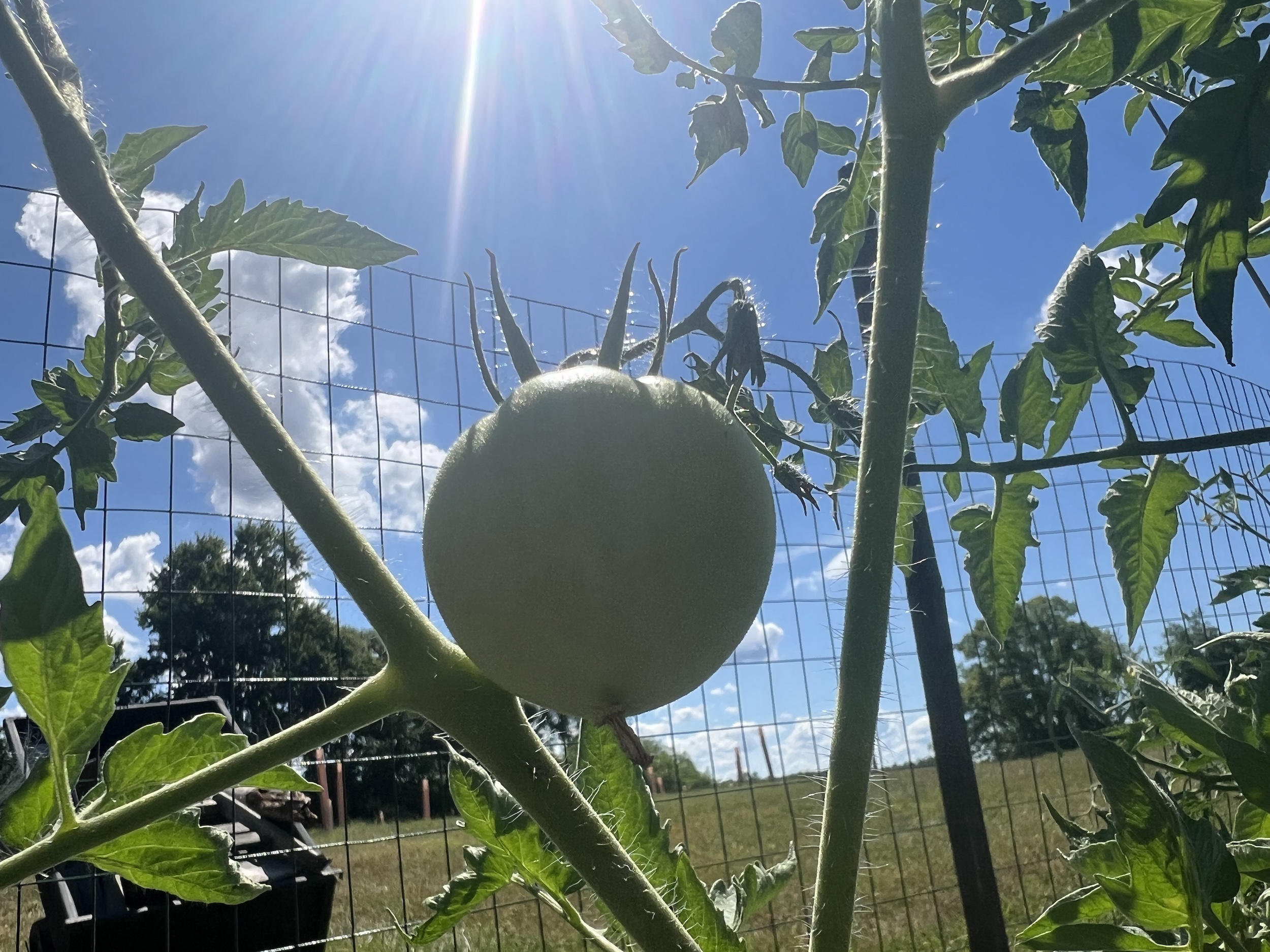The ripening of tomatoes—their sudden flushing on some warm afternoon, pink or orange or something chartreuse-ish, spreading up from the bottom, toward the stem—is not always a welcome development. Behold!
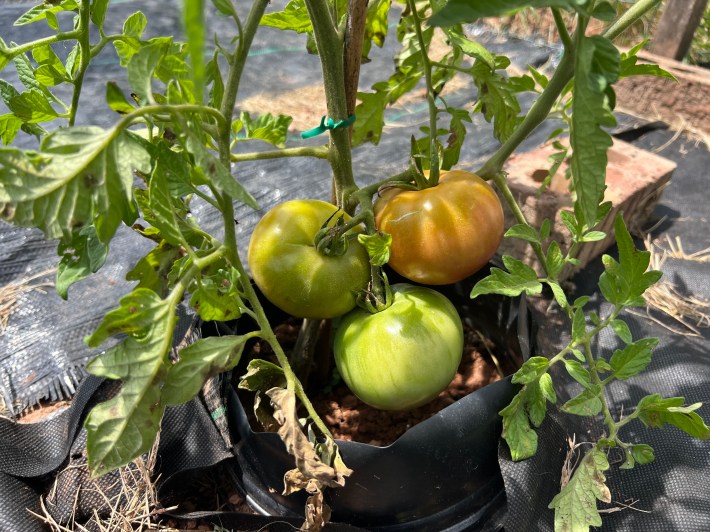
That photo was taken on the morning of June 25. Consulting your Tomato Time calendars will confirm for you—meaning me, in my plant hardiness zone—that this is way too early for ripening! Even with indeterminate tomatoes, the kind of plant that produces waves of tomatoes over the course of the season, this is precocious, pre–Tomato Time ripening. What you will also notice in this image is that those three tomatoes are growing and ripening right above the base of the plant, on a tiny little underdeveloped branch, from what can only have been the first few buds produced by this specimen. The bottommost tomato there is only about two inches above the soil. This is all wrong, and terrible.
The sensible and prudent thing to do when you install your tomato plants is to pluck off the early buds, and then to continue plucking off buds for another couple of weeks, so that your plant will fire all of its nutrients into growing large and thick and sturdy. The idea here is that a thicker and more robust plant will produce many more buds overall, and will have the sturdy frame to actually support the fruit that grows from those buds, and will have big wide highways for speeding nutrients along. Snipping off early buds is a very easy and very effective form of tomato care.
For reasons of being an impatient goober and a tomato freak, I did not do this. As a result, two of my plants are squat and flimsy and underdeveloped; not coincidentally they have pale tomatoes ripening way too early right above the ground, a miserable, humiliating gardening failure.
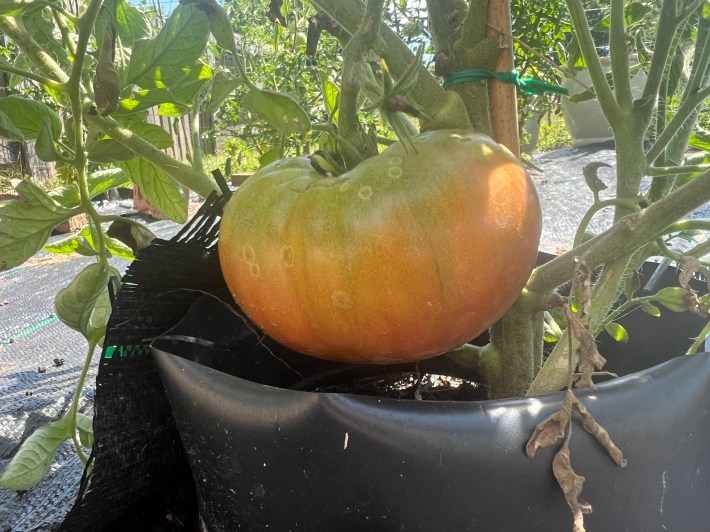
I'm going to blame some of this on the great heat dome of 2024. The U.S. Department of Agriculture warned farmers during the Northwest heat dome of 2021 that climate change will unleash these hellish conditions more regularly going forward, and that appropriate measures should be taken, although most of the measures described have to do with protecting workers and crops from scorching and dehydration. There's not too much in the literature about plants responding to unseasonable heat waves by zipping through the flowering phase before they've even gained their learner's permits. On the other hand, soil temperature plays a role in germination and root safety, and dry air circulation plays a role in the development and health of foliage, and ambient temperature plays a role in fruiting and ripening. Science tells us, confusingly, that heat hastens ripening, but that too much heat may actually slow ripening. The point is it was hotter than hell out there and now my tomatoes are ripening an entire month too early. You do the math!
As a consequence of all this too-early tomato action, even the more robust of my plants are on the flimsier side. A thunderstorm—in my limited defense, it was a genuinely shockingly violent thunderstorm—rolled through here after dark one recent evening and when I checked on things the following morning the destruction was paralyzing: slender limbs in whole new orientations, bent and in some cases visibly damaged, with handfuls of underripe fruit blown clear off and scattered underfoot. Days later, my tidy little garden is now like a Civil War hospital, with amputees and sickness and various improvised and plainly inadequate forms of wound management on shocking display. A tomato garden that had been tended with somewhat more care in the early stages of development—one where early buds had been dutifully plucked and the plants had been encouraged to grow heartily, to a condition of well-muscled maturity, before flowering—would almost certainly have taken less of a beating. After the storm's carnage, those plants today might even have as many or more viable green tomatoes growing on their beefy stem and limbs. Certainly they would not accuse me with their many gruesome injuries and sneer at me with their awful overdeveloped bottom-rung tomatoes.
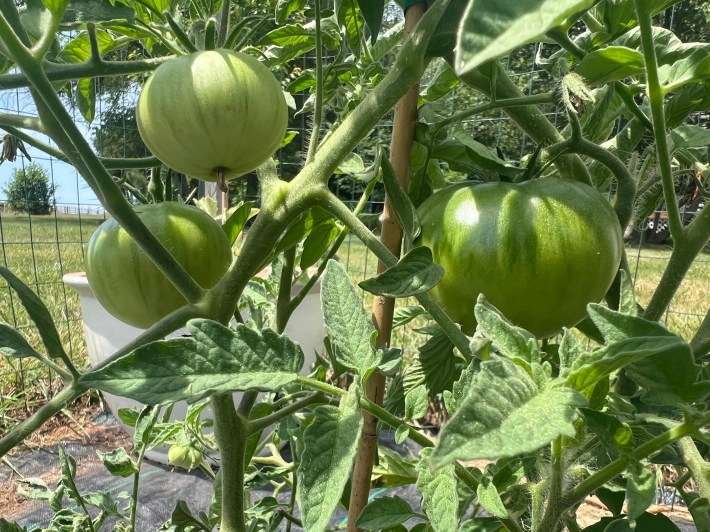
It may still be prudent to pluck these early suckers off the vines and huck them into the woods, and to meet the precocity of these out-of-control scamps with a week or two of discipline and tough love, so that they will get their acts together before creating offspring. I've thought about it! I may yet run out there in a fit and snip those few tomatoes loose and fire them off into nature, although time is now a factor. Some of the cultivars I have out there are expected to take 85 days from planting to harvest, and have now been in the ground for about half of that time. I am not in possession of an almanac but I assume optimal tomato-growing conditions will not persist into October, which leaves something like 90 days of season on the calendar. If I treat these misbehaving plants to a violent ritual rebirthing ceremony today, I will be cutting it awfully close for any kind of harvest.
I have not yet taken corrective action, even with this point of no return bearing down. First of all, I'm tempted by the opportunity to practice on these early tomatoes the methods of gauging ripeness, even while I know that declining to intervene means depriving my puny plants of guidance that would facilitate the accomplishing of other, longer-term and vastly more significant growth objectives. Second of all, and more significantly, I cannot talk myself out of the very distant hope that these insanely early tomatoes will ripen into the vibrant, warm, impossibly delicious tomatoes of a well-maintained home garden. Even though their skins are splitting! Even though they began growing and ripening before the start of summer, and while depending upon parent plants that were barely even adolescents. They can't possibly be expected to produce worthy tomatoes on such a schedule. Ah, says a different part of my brain, the one responsible for every purchase of Doritos I have transacted in my life, but maybe your plants are different. Special!
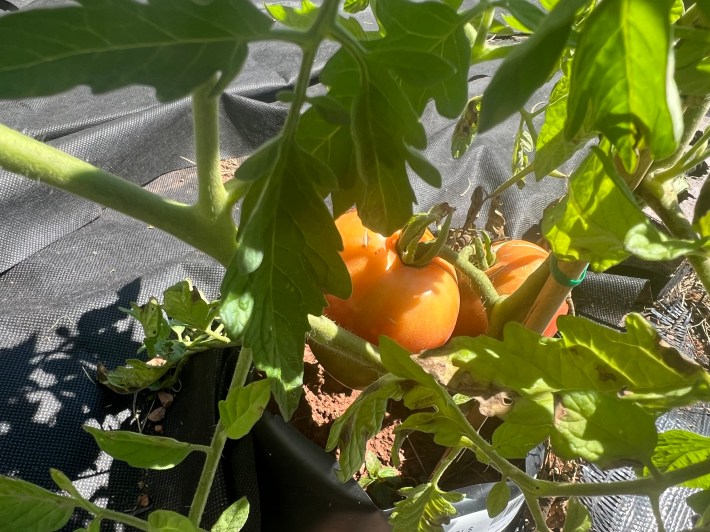
Tomatoes are generally an easy thing to grow, but this is at least the sixth time that I have had to relearn the important lesson that getting them into the ground is not even close to half of the battle. Spring is a time of enthusiasm for a reawakening nature. It's easier than it ever will be again to talk yourself into digging holes, mixing soil, massaging root clumps, watering, feeding, snipping, building a fence, inventing the door. A heat dome is designed by a cruel universe to kick that energy all the way out of you, by demanding that you fret over and helicopter-parent your plants, out under a baking, merciless sun, through an indefinite and brutally harsh trial of survival.
Spring also encourages in you a deceptive sense that a balanced nature, left as much as is comfortable to its own designs, has things entirely under control. Then summer's first ferocious heat wave somehow doubles or even triples the distance between your front door and your garden. Weeks later, a deformed and underdeveloped plant reminds you that nature did have everything under control, but that you and it did not necessarily share a common objective. You wanted maximized hauls of maximally delicious fruit, but the little bastard assigned to deliver the bounty was prioritizing the quickest possible route to seed deposit, plumping up minimally adequate early fruit way down there in the pest zone, with the actual purpose of summoning the assorted woodland jerks that you have labored to repel. This is how you repay me, you sob, holding up June's vulgar anti-harvest in sore fingers worked nearly to the bone at what you'd naively imagined was a common purpose.

There's still time. Tomato plants will not wait around forever, but the season is long, the plants are hearty and persistent, and as long as conditions hold the roots will be down there drinking up nutrition and firing it up the stem, like a pneumatic bank tube. My plants are lean and shaggy and overburdened—physically overburdened, visibly struggling—with the fruits of several decisions I have allowed them to make for themselves, but I can still get out there with the pruners and some twist ties and take matters in hand. I have probably lost any real opportunity to control the orientation of limbs on these guys, but I can certainly influence, if not command, where and how they direct their resources for the next little while.
Unfortunately, I also know that just as there is a Tomato Time there is a Tomato Fever, and I have contracted it. There must be 50 or more little green tomatoes out there; the thought of pruning that back at any meaningful scale and restarting the clock is frankly unbearable. We are, to some degree, locked in. The plants and I may have to white-knuckle it from here, but by God we will make it to the finish line, and soon. Tomato Time is so close, now. I can quite literally smell it.
